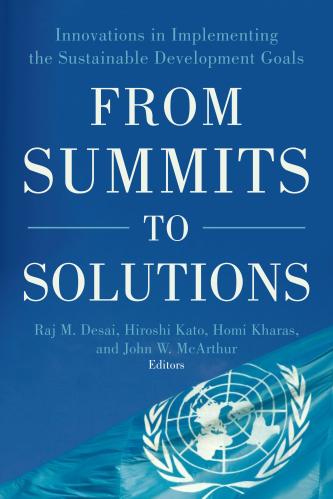Corporations are increasingly building sustainability into their business strategies, and linking outcomes to the Sustainable Development Goals (SDGs), as seen in the 7,500 companies issuing annual sustainability or corporate responsibility reports in accordance with the Global Reporting Initiative. Given this evolution in corporate thinking and action, the pertinent questions are “why” and “how.”
To investigate, we studied 40 companies with a strong record on sustainability. A desktop review provided a foundation and structured interviews with executives of 14 of the companies provided detail and nuance. Here is what we learned.
Deliberate Process
Unlike many civil society organizations and governments, corporations do not automatically make the link between their mission and sustainability, or simply review the SDGs and sign on. They go through a deliberative evolutionary process. First, a progressive acknowledgement of the importance of environmental, social, and governance issues (ESG) to the company’s business interests. That leads to an understanding of the relevance of the broader issue of sustainability and, for some companies, subsequently seeing how specific SDGs fit with their business interests.
The “drivers” that link sustainability and the SDGs to the corporate interest can be either business-case or values-case. The business case for the SDGs is best articulated at a macro level by the report of the Commission on Business and Sustainability—capped by identification of a $17 trillion market potential for four of the SDGs by 2030.
Business-case drivers involve maximizing growth opportunities and minimizing risk and are the rationale for 80 percent of the companies studied. A few have moved a step further to a values-case by adopting a corporate values or purpose statement that moves the corporate strategy beyond just financial return.
More than half the companies studied link their corporate strategy to specific SDGs connected to their business activity and to which they plan to contribute. The SDGs provide a useful frame, both internally and externally, to organize and articulate a company’s sustainability goals.
Embedding Sustainability
Companies embed sustainability in their corporate strategies through three mechanisms:
Strategic Integration is the starting point. This occurs with the transition of the business strategy from focusing just on creating shareholder value to creating shared value. It involves incorporating ESG, alongside financial returns, into the corporate strategy.
Operational Integration involves identifying and communicating specific, measureable, time-bound goals to hold the company accountable for the strategy. Companies in the sample averaged four to five impact goals. Companies determine key impact areas by engaging stakeholders in identifying and managing sustainability issues that are likely to affect the business the most and where the company can have the greatest impact. The SDGs most frequently linked to corporate strategies are 8 (decent work and economic growth), 12 (responsible consumption and production), and 17 (partnerships for the goals).
Organizational Integration is a complex process that extends from the boardroom to the loading dock. It involves strong thought leadership from the board and senior company executives and buy-in all the way down the line. At the governance level, companies execute this function through a board committee on sustainability, an executive providing oversight on sustainability, and/or cross-functional sustainability management.
Measurement
Company officials highlighted the challenge of measuring goals. They expressed frustration at the lack of consistent tools and methodologies to assess impact, especially for social and governance issues. Resource constraints also limit impact measurement, with corporations having to incur a substantial cost for the assessment with limited visible value-add. Measuring outcomes is more readily performed at the program level and more difficult in aggregation and determination of overall impact. Jane Nelson identifies the sources of this frustration in reporting that more than 100 sustainability raters administer questionnaires to companies. Efforts to standardize the field include the Global Reporting Initiative and the Worldwide Benchmarking Alliance.
Good Practices
Since companies operate in industries with different business and regulatory landscapes, there is no one identified best practice that results in a sure shot success of sustainability integration. Nevertheless, our study found six good practices of companies adopting a sustainability strategy:
- Identify the key drivers
- Formulate a strategy that encompasses both sustainability and business goals
- Identify and communicate specific, measurable, and time-bound sustainability goals
- Create a stakeholder management strategy on sustainability issues
- Build partnerships and alliances that leverage core capabilities
- Embed and integrate sustainability within main business functions
Conclusion
Companies tend to prioritize SDGs that align with their core business, rather than taking an all-encompassing approach. Most companies see their contribution to the SDGs directly through corporate sustainability goals and practices.
Our findings fit with a recent PWC survey of more than 700 global companies, which reports that 72 percent of companies reference SDGs in annual corporate or sustainability reports, 50 percent identify priority SDGs, and 54 percent mention them in their business strategy. There clearly is a broad trend, to which we hope our study opens a window on how companies are adapting to the SDGs.
The Brookings Institution is committed to quality, independence, and impact.
We are supported by a diverse array of funders. In line with our values and policies, each Brookings publication represents the sole views of its author(s).




Commentary
How corporations are approaching sustainability and the Global Goals
January 8, 2019